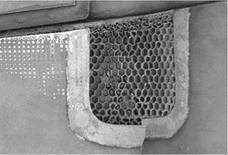As illustrated in Figure 7.71, damage occurred in a honeycomb structure of a service hatch of an aircraft; here, a delaminated glass-fiber patch impaired the function of an engine control unit. The distance between the hatch and a heat exchanger nearby was less than 2 mm in some places, while in some areas they even came into contact with each other.
The honeycomb structure and the glass-fiber patch had been bonded with an epoxy resin system containing dicyandiamide as hardener. Dicyandiamide is identified, using IR spectroscopy, by two bands at 2190 and 2160 cm-1, respectively. These bands result from a C=N bond and can be used to detect the thermal load of the adhesive. Additionally, in the case of a high temperature caused by oxidation, a band structure is generated in the carbonyl stretch (C=O vibration) region (at around 1680 cm-1). From the comparison between the results obtained with the defective hatch and those obtained with temperature-aged reference samples, two potential thermal histories were determined: long-term exposure of the hatch to more than 180 °C, or to 240 "Casa short-term exposure. Of these two possibilities, the long-term exposure was the more likely (Figure 7.72).
When assessing the possible thermal load, the thermal conductivity of the adherents and possible heat dissipation by the structure had to be considered. Compared to the glass-fiber patch, the thermal conductivity of aluminum was very high; hence, near the aluminum outer cover sheet the heat had dissipated into the
|
|
structure, limiting the thermal load to which the adhesive was subjected where it contacted the aluminum. In contrast, where it contacted the glass-fiber patch, no heat dissipation had taken place. Consequently, the surface of the glass fibers was heated up and a considerably higher temperature reached. This thermal load at the glass — fiber patch eventually resulted in failure of the adhesive and delamination.
7.8.7
 2 ноября, 2015
2 ноября, 2015  Pokraskin
Pokraskin 
 Опубликовано в рубрике
Опубликовано в рубрике 